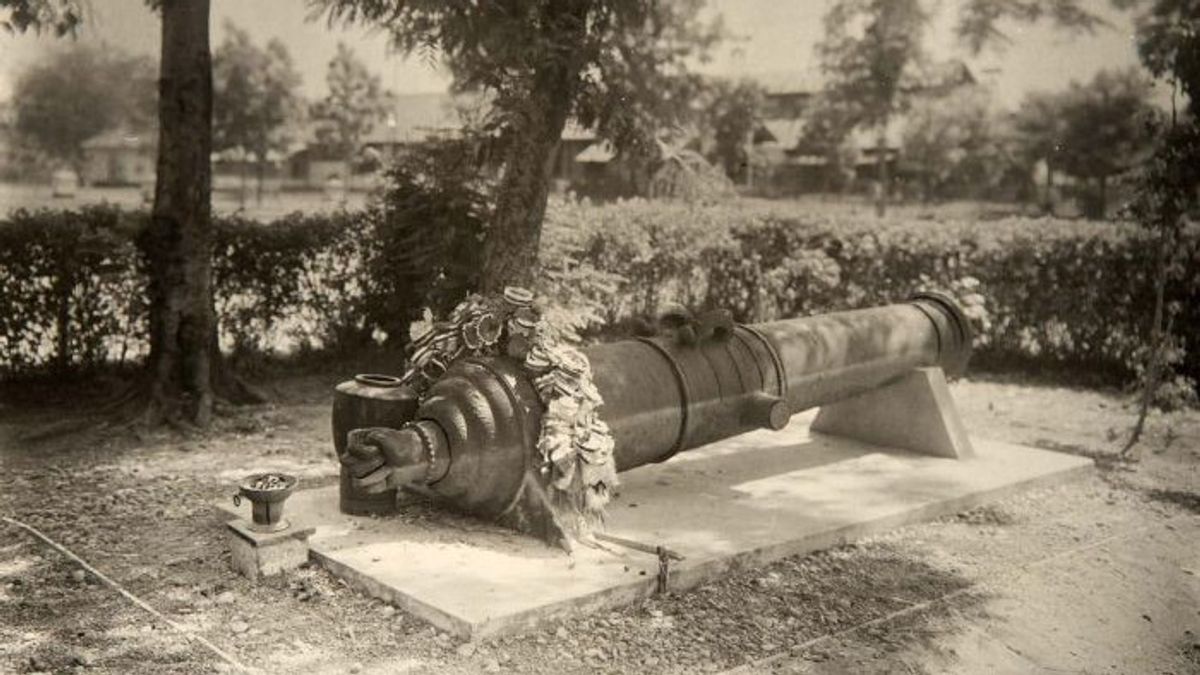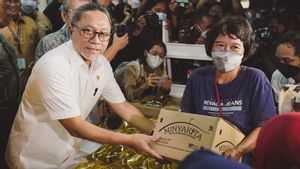JAKARTA - The growth and development of Batavia could not be separated from the influence of the Portuguese. The dominance of the Portuguese language in the daily conversation of the Batavian people is proof. That's not all. Portuguese influence continues to expand in a variety of cultures – from cuisine to art to weapons of war. The Jagur cannon is one of them. The Si Jagur cannon is considered sacred because of its unique shape. It is said that any request, including wanting to have children, is often granted. People were busy giving him offerings.
The establishment of the City of Batavia became an early sign of the presence of Dutch colonialism in Indonesia. The Dutch trading company VOC was the creator. Jayakarta was conquered, Batavia was founded in 1619. The VOC made Batavia resemble cities in the Netherlands. The residents can't be any. Aliases selected. Most of the Bumiputras were forbidden to live in Batavia. Except for the interested bumiputras. Like those who devoted themselves in the military service of the VOC. War soldiers under the leadership of Kapitan Tahalele from Luhu Island, for example.
One of the other backgrounds of the residents of Batavia was the freed slaves. The slaves mostly came from VOC prisoners of war when they conquered Portuguese colonies. In Malacca or India. They included slaves who were freed by the Portuguese because they wanted to convert to Christianity. The free slaves of the “Black Portuguese” were forever called the mardijkers.
By the Dutch, the mardijker were given special privileges. The mardijker were also transformed into an important element that drives the economy in Batavia. Even their arrival made their daily activities dominated by the Portuguese language.
“Around 1670 these 'citizens' who bore Portuguese names after occupying the VOC lodge at Jaccatra; they, among others, came from Portuguese frigates seized by the VOC. A number of others volunteered to work for the Company and came from shelters such as Sukadana, Jambi, or came directly from the Coromandel Coast, India.”
“They were tough workers for the first years. They work in exchange for food and rice rations before finally getting a fixed monthly salary. Some of them were recruited to become leaders in charge of overseeing the slaves. The slaves were imported by the Company from coastal areas in India,” said Hendrik E. Niemeijer in the book Batavia of the Colonial Society of the XVII Century (2012).
The arrival of the mardijker made Portuguese widely used in Batavia. Including in the markets. In addition to speaking Portuguese, they show their identity by wearing European-like clothing. They wore sloppy pants, black European hats, and wore socks and shoes.
Therefore, the mardijkers were able to establish themselves – like the Europeans – who were able to fill all forms of professions in Batavia. From ship craftsmen to slave foreman, a series of jobs that often make them live well, even rich.

Illustration of the old Si Jagur Cannon (source: Wikimedia Commons)
The great influence of the mardijker indirectly expanded Portuguese culture. Language is one of them. They also live as equals with the Dutch. Moreover, the mardijkers obtained a residence permit in the city of Batavia or the area outside the walls of Batavia which lasted forever known as the Ommelanden area.
“The languages that are often used in Batavia are Portuguese, Low Malay, and Dutch. There are also Javanese, Chinese, and other languages of the people who live here, but these languages are only used to communicate among themselves, never used by other nations.”
“But Portuguese and Malay are two languages that can be used to communicate with everyone. Not only in Batavia, but also for all of India to Persia,” said Francois Valentijn as written by Jean Gelman Taylor in the book Social Life in Batavia (2009).
The Jagur CannonThe conquest of the Portuguese colony by the VOC not only brought in the mardijkers, but the conquest also brought a cannon from Malacca. The cannon is widely known as the Jagur Cannon.
Previously, Si Jagur Cannon was once part of the Santo Jago de Barra Fort, then moved to the Portuguese Fort in Malacca. The VOC realized the presence of the Jagur Cannon when it attacked Malacca. The Company was well aware that the cannon was made by the famous gunsmith who had lived in Goa, India, namely Manual Tavares Baccarro.
The ambition of owning a cannon immediately fused with the spirit of defeating the Portuguese. The VOC also won and brought the Cannon with the victory trophy to Batavia in 1641. The Si Jagur Cannon was then placed in Kasteel Batavia.
“The Jagur was brought to Batavia after the VOC captured Malacca (1641). Then the cannon that spewed 24 pound bullets was placed in Batavia Fort to guard the harbor. Apparently, this cannon was forgotten or left behind because it was too heavy, when the fortress of Batavia was demolished by Daendels (1809).”
“On this cannon it is written in Latin: EX me Ipsa renata sVm – from myself I was born again. This sentence shows, that Si Jagur is poured from 16 (=X+I+V) small cannons. This cannon was poured by MT Bocarro in Macau for the Portuguese Fort in Malacca,” the story of an important figure in the history of Jakarta, Adolf Heuken SJ in the book Historic Places in Jakarta (2016).
considered sacredThe move of downtown Batavia from the old Batavia (Oud Batavia) to the Weltevreden area (Nieuw Batavia) marked the new designation of the Si Jagur Cannon. The cannon which was originally intended to strengthen the fortifications, is now abandoned in Oud Batavia. As a result, the unique shape of the cannon and symbolizing mano in fica (symbol of intercourse) is considered sacred and powerful. The cannon with the shape of a pinched thumb is believed to bring many benefits. It is said that whatever his request – from wanting to be rich, smooth fortune, a mate, to having children – can be granted immediately. Those who came asking for various kinds of wishes came from various circles, the Bumiputra, the Chinese, to the Indos.
“The old gate to Kasteel Batavia is still there. Just outside the door, in the middle of the grass field was a large and famous bronze cannon. The Portuguese heritage cannon has a twin in Banten. People say, as long as the two cannons are separated, the Dutch will still control Java."
“The back of the huge cannon is in the shape of a fist clenched with the thumb protruding between the index and middle fingers. The cannon is considered sacred and can give fertility. That's why many women worship this object to ask for children. I saw dishes placed there: small paper umbrellas, flowers, incense, and even food,” concluded Justus van Maurik in the book Ketoprak Betawi (2001).
The jury for the Si Jagur Cannon did not forget to add to the sacred dignity of the object by actively bathing the cannon with flower water until it was sprinkled with flowers. The echo of the greatness of the Si Jagur Cannon as a sacred object began to spread.
Those who came not only from Batavia, but from outside Batavia, such as Bandung, Cirebon, and Surabaya. Those who come believe that their request can be granted by Si Jagur.

Illustration of the old Si Jagur Cannon (source: Wikimedia Commons)
This condition even persisted until Indonesia's independence. Even though the pilgrims who come are limited to people from the village, the arrival of pilgrims is a sustenance for those who sell around the Si Jagur Cannon. They also get a windfall.
Their merchandise is selling well, especially on Sundays. The ones who benefit the most are the sellers of offerings because those who come are required to bring offerings. For the sake of smooth prayer, he said. Then, the pilgrim will be asked to immediately sprinkle flowers and burn incense when making a vow in front of the Thumbs Up.
“I can also add here, in the 1950s the famous Si Jagur Cannon was still located in a field on the left side of Jalan Cengkeh leading to the Old Fish Market, not far before the Fish Market. Many villagers go on pilgrimages to this Portuguese heritage cannon by bringing alms and sprinkling flowers on it. The pilgrimage to the Si Jagur Cannon is believed to be able to give blessings to couples who want children.”
"I don't know why and how this belief came to be, I don't know for sure. Perhaps because of the shape of the hand grip with the thumb inserted between the index and middle fingers located at the base of this cannon, which is symbolized as a symbol of sex and fertility. At that time, there were many residents of Jakarta, mostly villagers, who still believed in such superstitions,” said Firman Lubis in his book Jakarta 1950-1970 (2018).
*Read other information about JAKARTA HISTORY or read other interesting articles from Detha Arya Tifada.
Other MEMORIESThe English, Chinese, Japanese, Arabic, and French versions are automatically generated by the AI. So there may still be inaccuracies in translating, please always see Indonesian as our main language. (system supported by DigitalSiber.id)










